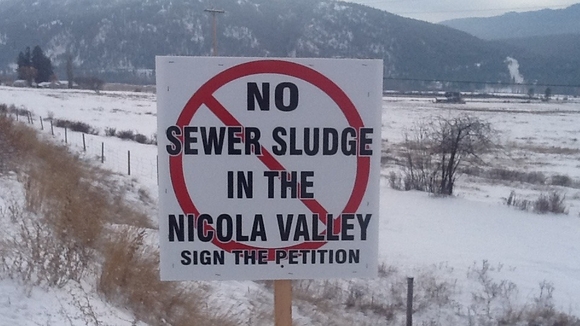VANCOUVER – Residents of Merritt are fighting back against the decision to truck what they call ‘sewage sludge’ from the Fraser Valley and the Interior to a location in their city.

Sewage sludge is the by-product produced during the treatment of waste. However, it is now known as biosolids, which are digested sewage solids said to be rich in nutrients. It has been spread on farmland for many years.
Georgia Clement, from Friends of the Nicola Valley, said the current dumping location is on Sunshine Valley Road in Merritt and there are plans for another dumping site on a second plot of land, known as Dry Lake. “They are composting it at the Sunshine Valley site and then wanting to take it to Dry Lake,” she said.
Many of the residents want to stop this practice from happening, especially so close to their homes and water supply. “Dry Lake is directly uphill from our 44 subdivision that has one community well that supplies our drinking water,” said Clement. “It’s less that 1 kilometre away.”
Timbro Contracting has the multi-million dollar contract to truck the biosolids from Abbotsford and the Okanagan-Similkameen and a spokesperson for the Ministry of Environment said the owner or operator of the treatment facilities is responsible for managing the solid by-product.
Clement said not only are they angry about the biosolids contaminating the land, but also about the fact no residents were consulted on the decision. “There has to be some more dialogue, consultation,” she said.
A spokesperson for the Ministry of Environment (MOE) said while they have to be notified prior to a biosolids application to the land base, public notification of the land application is not required. However, some companies provide public notification on a voluntary basis. “Depending on the quality and class of biosolids, having visible signage after land application that explains the land application and the required restrictions is mandatory under the regulation. Ministry staff have been engaging with the public by answering inquiries and receiving concerns,” the spokesperson said.
The Nicola Watershed Community Round Table is organizing a workshop to provide a forum for education and discussion of the issues on Jan. 26, and the Ministry of Environment, Interior Health Authority and the Thompson Nicola Regional District (TNRD) will be attending. The Ministry and Health Authority staff will also be presenting to the TNRD Board on Feb. 5, to inform board discussions.
But Clement said they want to see more done to stop this practice outright from happening in their community. “There is no satisfaction for us until this does not exist in the TNRD,” she said.
The MOE said the dumping of biosolids is safe to human health and the environment. “The regulation sets standards for metals and pathogen levels in biosolids,”said the spokesperson. “The land application of biosolids requires a land application plan that is completed by a qualified professional in accordance with the criteria set out in the regulation.” This includes the amount of nutrients and allowable level of pathogens, the rate of land application and the necessary post-application monitoring plans.
“The regulation also prescribes setbacks from water, roads and properties and restrictions, based on quality and class of biosolids, for animal grazing and planting food crops for human consumption,” added the spokesperson.
Residents are gearing up for a fight however.
“There’s now a groundswell of serious discontent and worry,” said Clement.
Many eyes are now on the Dry Lake site. “The proponent has been directed to provide additional information about their application plan regarding setbacks from surface water and slopes, and an evaluation of groundwater depth, drinking water and habitat protection, among other detailed considerations,” said the spokesperson from the MOE. “The land application may not occur at this site until the additional information has been provided and both the Interior Health Authority and MOE have again reviewed the information.”
To follow the story, check out the Facebook page, Friends of the Nicola Valley. There is also an online petition.




Comments